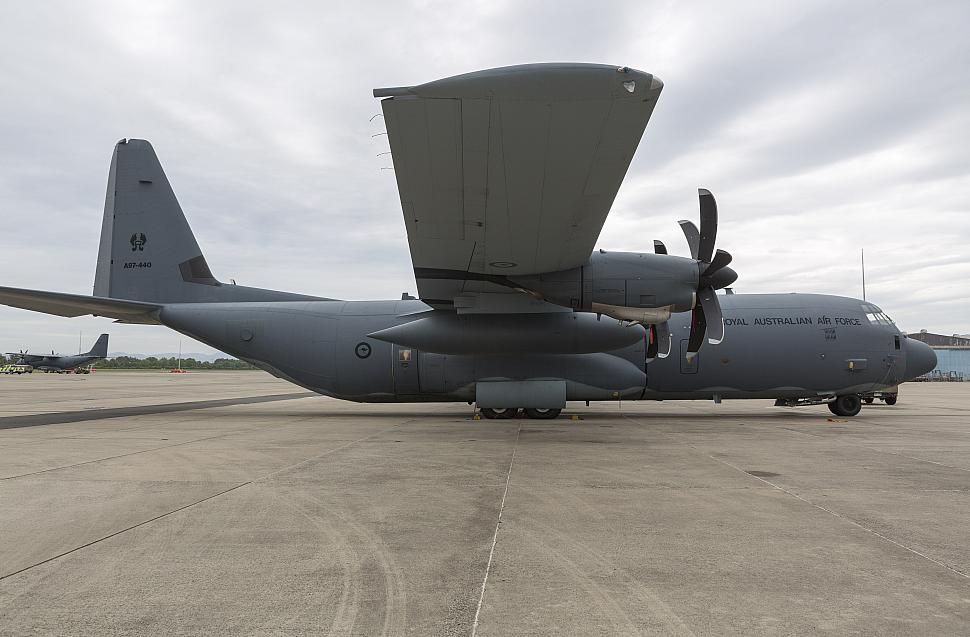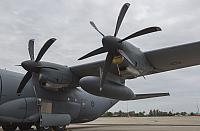C-130 News
C-130 Hercules News
External fuel tanks trial on RAAF C-130J Hercules
November 17, 2018 (by
Asif Shamim) -
External fuel tanks will be trialled on a pair of Royal Australian Air Force C-130J Hercules transport aircraft over the next 12 months.

The fuel tanks increase the fuel capacity of a Hercules from 19 tonnes to 27 tonnes.
In November, the first aircraft to receive these tanks – serial #A97-440 – was handed over to No. 37 Squadron at RAAF Base Richmond following routine scheduled maintenance from Airbus Group Australia Pacific.
Air Commodore William Kourelakos, Commander Air Mobility Group, said the utility of these fuel tanks would be explored in a variety of missions.
"Extra fuel is useful during Forward Arming and Refuelling Point operations, where the crew land and offload fuel to another aircraft, vehicle or storage tank," Air Commodore Kourelakos said.
"The fuel tanks can also extend range or endurance during certain missions, allowing us to be more persistent in an area such as during Search and Rescue missions."
"Carrying that extra fuel brings weight and drag considerations, so this trial will determine how these tanks might benefit our future airlift operations."
Older models of the Hercules were equipped with external fuel tanks, and the tanks used in this trial have been refurbished from remaining stock after the retirement of the C-130H Hercules in 2012.
The C-130J was introduced to RAAF service in 1999 without external fuel tanks, due to its engines being more efficient and more powerful than those that powered earlier generations of Hercules.
The utility of these fuel tanks will be explored this December, with A97-440 expected to support Operation Christmas Drop in Guam. Hosted by the United States Pacific Air Forces, Operation Christmas Drop involves the delivery of donated gifts including food, clothing and toys to remote island communities in the West Pacific.
"Some of these missions are to islands more than 2000 kilometres from Guam, where there's very limited options to divert in the event of an emergency," Air Commodore Kourelakos said.
"Carrying that extra fuel would make some aspects of mission planning easier, allow crews to deliver to more island communities, or increase the amount of time loitering at a Drop Zone."

RAAF C-130J Hercules #A97-440 fitted with external fuel tanks as part of a trial to determine the value of extra fuel capacity in the Hercules fleet as seen on November 14, 2018. [ Photo by CPL David Gibbs, © Commonwealth of Australia, DoD]
In November, the first aircraft to receive these tanks – serial #A97-440 – was handed over to No. 37 Squadron at RAAF Base Richmond following routine scheduled maintenance from Airbus Group Australia Pacific.
Air Commodore William Kourelakos, Commander Air Mobility Group, said the utility of these fuel tanks would be explored in a variety of missions.
"Extra fuel is useful during Forward Arming and Refuelling Point operations, where the crew land and offload fuel to another aircraft, vehicle or storage tank," Air Commodore Kourelakos said.
"The fuel tanks can also extend range or endurance during certain missions, allowing us to be more persistent in an area such as during Search and Rescue missions."
"Carrying that extra fuel brings weight and drag considerations, so this trial will determine how these tanks might benefit our future airlift operations."
Older models of the Hercules were equipped with external fuel tanks, and the tanks used in this trial have been refurbished from remaining stock after the retirement of the C-130H Hercules in 2012.
The C-130J was introduced to RAAF service in 1999 without external fuel tanks, due to its engines being more efficient and more powerful than those that powered earlier generations of Hercules.
The utility of these fuel tanks will be explored this December, with A97-440 expected to support Operation Christmas Drop in Guam. Hosted by the United States Pacific Air Forces, Operation Christmas Drop involves the delivery of donated gifts including food, clothing and toys to remote island communities in the West Pacific.
"Some of these missions are to islands more than 2000 kilometres from Guam, where there's very limited options to divert in the event of an emergency," Air Commodore Kourelakos said.
"Carrying that extra fuel would make some aspects of mission planning easier, allow crews to deliver to more island communities, or increase the amount of time loitering at a Drop Zone."
Courtesy of © Royal Australian Air Force
Related articles:
Forum discussion:
Tags
Forum discussion:
- Start a discussion about this article in the C-130.net forum.
Tags

